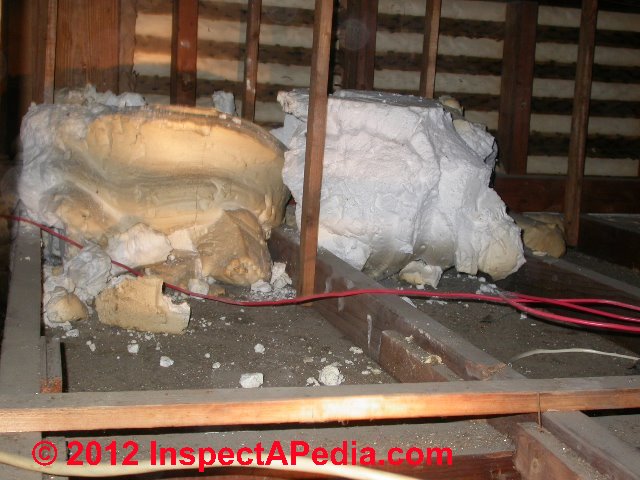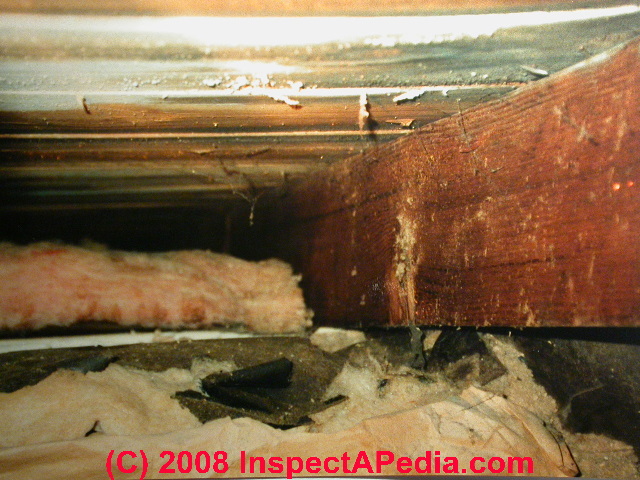 UFFI - Urea Formaldehyde Building Insulation
Lawsuit
UFFI - Urea Formaldehyde Building Insulation
Lawsuit
UFFI class action cease & desist: RetroFoam Canada
- POST a QUESTION or COMMENT about UFFI Urea Formaldehyde Insulation in buildings and its effects on the property
UFFI class action lawsuit:
This article reports on class action litigation involving RetroFoam Canada, a company based on Breslau Ontario, and a cease and desist order to the company's dealer-installers prohibiting the insulation companies from installing RetroFoam.
This article series on UFFI insulation illustrates and describes UFFI - urea formaldehyde foam building insulation and describes where it is found, when it was used in buildings, how to look for it, how to distinguish this from other building foam insulation products, and its health effects.
InspectAPedia tolerates no conflicts of interest. We have no relationship with advertisers, products, or services discussed at this website.
- Daniel Friedman, Publisher/Editor/Author - See WHO ARE WE?
UFFI Urea Formaldehyde Insulation Class Action Lawsuit in Canada 2009

Watch out: The Spring 2009 issue of The Canadian Home Inspector, published by the CAHI, the Canadian Association of Home Inspector, reports on a lawsuit involving contemporary installation of UFFI urea formaldehyde foam insulation in a Canadian home during 2008 despite the fact, as CAHI reports, that the Canadian government has banned the use of UFFI in homes since 1980.
The Canadian Home Inspector indicated that Rob and Michelle Cecile are plaintiffs in a $500-million class-action lawsuit against RetroFoam, a foam retrofit insulation product that Health Canada says contains "... a toxic substance ...".
The Cecile family indicated that the AmeriSpec home inspector, licensed through the Canadian federal EcoEnergy program, had a financial interest in the local RetroFoam franchise.
Our understanding is that the inspector was hired as Federally licensed energy auditor, not as a home inspector.
He was not doing a home inspection. There are many inspectors and contractors who recommend products in which they have a financial interest in the energy audit business.
We are informed that one energy audit company pays its auditors nothing for the audit work. The auditor only gets a percentage for the stuff that they get the homeowner to buy.
The Canadian Association of Home Inspectors includes a code of ethics that may have precluded a home inspector from making such a recommendation.
According to CAHI, the Canadian federal government has issued a cease and desist order to RetroFoam Canada, a company based on Breslau Ontario, and has issued a cease and desist order to the company's dealer-installers as well, prohibiting the insulation companies from installing RetroFoam.
Retrofoam, according to Health Canada, contains urea formaldehyde - UFFI. "The substance causes respiratory problems and cancer" the article continues. "A posting on retroFoam's website does not deny the presence of UFFI, but says its product is safe."
As it was reported, U.S. manufacturer did not disclose to the Canadian company importing the product that there was any UFFI in the product.
Robert and Michelle Cecile also assert that the installation of UFFI in their home using the Retrofoam product that contains urea formaldehyde foam insulation has stigmatized their property and thus reduces its property value.
See ENVIRO-SCARE DEFINITION, EFFECTS for more information about the common effects of environmental hazards and scares on property values and property resale time.
Beginning at UREA FORMALDEHYDE FOAM INSULATION, UFFI we provide history and information about the health concerns associated with this product.
A rough summary: early research suggesting a cancer link with UFFI was later found not to be substantiated; a possible formaldehyde sensitivity remains for people suffering from MCS.
Where UFFI contained measurable formaldehyde outgassing, that process was found to diminish to below 0.01 ppm or possibly even below the limits of detection as the foam cured.
Current sources of formaldehyde in buildings where old UFFI is present can be expected to be traced to other materials than the UFFI, such as laminated or pressed-wood products.
However, regardless of any ongoing argument about the level of health risk with a UFFI installation, as reported by CAHI, a home inspector, having a financial interest in the insulation company, recommended home insulation retrofit installation of a material banned in Canada.
Readers concerned about exposure to formaldehyde gas indoors should
see FORMALDEHYDE HAZARDS - topic home, where we describe the sources of this contaminant, exposure levels,
and steps to reduce formaldehyde levels indoors, and
see FORMALDEHYDE GAS HAZARD REDUCTION
Readers should also see a similar looking but modern foam insulating product
at ICYNENE FOAM SPRAY INSULATION - How to Identify Icynene Foam Insulation
If you are having trouble determining what type of foam insulation product has been installed in a building,
see FOAM SPRAY INSULATION TYPES - How to Make a Sure Distinction Among UFFI, Icynene, and Latex Foam Insulations for more detail on the identification of these products in the field.
Health Canada Statement on UFFI
UFFI, which is foamed in place and used to insulate buildings, has been banned in Canada under the Hazardous Products Act (HPA) since December 1980.
UFFI was banned due to the high levels of formaldehyde that were given off during the installation process, as well as the continued off-gassing of formaldehyde from poorly installed insulation.
The amount of formaldehyde released by UFFI was highest when first installed and decreased over time.
As a result, UFFI installed before 1980 would have little effect on indoor formaldehyde levels today. If UFFI gets wet, however, it could begin to break down and may release more formaldehyde. Wet or deteriorating UFFI should be removed by a specialist and the source of the moisture problem should be repaired.
Some provinces require homeowners to declare if they have UFFI installed, and this issue is generally raised during the re-sale of older homes.
For more information on UFFI please see Health Canada's It's Your Health factsheet on Formaldehyde or the Canada Mortgage and Housing Corporation (CMHC) - Health Canada, "Formaldehyde in Indoor Air", Health Canada . Sante Canada, retrieved 29 March 2015, original source: http://www.hc-sc.gc.ca/ewh-semt/pubs/air/formaldehyde/fact-info-eng.php
...
Reader Comments, Questions & Answers About The Article Above
Below you will find questions and answers previously posted on this page at its page bottom reader comment box.
Reader Q&A - also see RECOMMENDED ARTICLES & FAQs
How can the Health Canada IAQ Test for formaldehyde GAS in the Building Envelope?
How can the Health Canada IAQ Test for formaldehyde GAS in the Building Envelope in any way be a fair test procedure when their are 267 other formaldehyde sources of Formaldehyde being tested inside the indoor contaminated test area?
2nd How can this test result of a GAS in one area possibly relate in any way to a Quasi Pre-polymer Solid Cellular Plastic (UFFI) in a completely different Outside Area, separated by a Canadian Building Code Mandatory Vapor Barrier outside the indoor air test area.
3rd Isn't this just Junk Corrupt Canadian Government Science and Fear Mongering solely to extort industry kick backs, verifyable by UFFI Industry experts clearly advised that testing inside air only provides test results for the ubiquitous indoor formaldehyde gas from other indoor products?
4th How can Health Canada possibly justify the stigmatization of homes all across Canada for no just Scientific Health Safety Reason. Retrofoam Insulation a health safety hazard as claimed by Health Canada is seriously flawed It's impossible
Well what do you have to say about my comments? - On 2011-12-01 by ajefford@yahoo.com -
Reply by (mod) - crumbling and dusting UFFI and no current offgassing issue
Ajefford, we agree with the question you raise, that there can be multiple sources of formaldehyde outgassing in a building.
And breathing any very small dust particles can be a respiratory hazard;
There is no data supporting a claim that homes insulated with UFFI in the 1970s have an ongoing formaldehyde off-gassing problem that would be traced to that insulation today.
Depending on how and where a test is conducted, however, an narrow down or even eliminate that confusion.
In our OPINION the bottom line is that even when improperly mixed and installed so that formaldehyde outgassing occurred in UFFI insulation jobs (typically during the 1970's in North America), the open celled foam outgassed completely over several years at most.
It is unlikely that we will detect formaldehyde outgassing today from 40 year old foam or if we do, it's likely to be at low levels, below 0.01 ppm.
...
Continue reading at UREA FORMALDEHYDE FOAM INSULATION, UFFI - topic home, or select a topic from the closely-related articles below, or see the complete ARTICLE INDEX.
Or see these
Recommended Articles
- FORMALDEHYDE HAZARDS - home
- UREA FORMALDEHYDE FOAM INSULATION, UFFI - home
- URETHANE FOAM DETERIORATION & OUTGASSING
Suggested citation for this web page
UFFI CLASS ACTION LAWSUIT, CANADA at InspectApedia.com - online encyclopedia of building & environmental inspection, testing, diagnosis, repair, & problem prevention advice.
Or see this
INDEX to RELATED ARTICLES: ARTICLE INDEX to BUILDING INSULATION
Or use the SEARCH BOX found below to Ask a Question or Search InspectApedia
Ask a Question or Search InspectApedia
Questions & answers or comments about how to recognize UFFI Urea Formaldehyde Insulation in buildings.
Try the search box just below, or if you prefer, post a question or comment in the Comments box below and we will respond promptly.
Search the InspectApedia website
Note: appearance of your Comment below may be delayed: if your comment contains an image, photograph, web link, or text that looks to the software as if it might be a web link, your posting will appear after it has been approved by a moderator. Apologies for the delay.
Only one image can be added per comment but you can post as many comments, and therefore images, as you like.
You will not receive a notification when a response to your question has been posted.
Please bookmark this page to make it easy for you to check back for our response.
IF above you see "Comment Form is loading comments..." then COMMENT BOX - countable.ca / bawkbox.com IS NOT WORKING.
In any case you are welcome to send an email directly to us at InspectApedia.com at editor@inspectApedia.com
We'll reply to you directly. Please help us help you by noting, in your email, the URL of the InspectApedia page where you wanted to comment.
Citations & References
In addition to any citations in the article above, a full list is available on request.
- 3/07: thanks to Gary Randolph, Ounce of Prevention Home Inspection, LLC Buffalo, NY, for attentive reading and editing suggestions. Mr. Randolph can be reached in Buffalo, NY, at (716) 636-3865 or email: gary@ouncehome.com
- Thanks to reader Anna Marron for discussion of UFFI-insulated building retrofit options 05/29/2010
- Our recommended books about building & mechanical systems design, inspection, problem diagnosis, and repair, and about indoor environment and IAQ testing, diagnosis, and cleanup are at the InspectAPedia Bookstore. Also see our Book Reviews - InspectAPedia.
- In addition to citations & references found in this article, see the research citations given at the end of the related articles found at our suggested
CONTINUE READING or RECOMMENDED ARTICLES.
- Carson, Dunlop & Associates Ltd., 120 Carlton Street Suite 407, Toronto ON M5A 4K2. Tel: (416) 964-9415 1-800-268-7070 Email: info@carsondunlop.com. Alan Carson is a past president of ASHI, the American Society of Home Inspectors.
Thanks to Alan Carson and Bob Dunlop, for permission for InspectAPedia to use text excerpts from The HOME REFERENCE BOOK - the Encyclopedia of Homes and to use illustrations from The ILLUSTRATED HOME .
Carson Dunlop Associates provides extensive home inspection education and report writing material. In gratitude we provide links to tsome Carson Dunlop Associates products and services.

